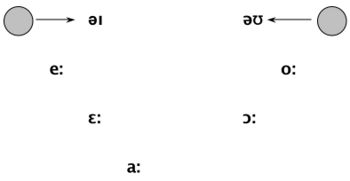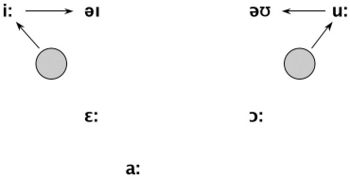Chain shift
Chain shift is a series of interrelated sound changes. The assumption behind the chain shift is that all the phonemes of a language build a balanced system so that a change in one part of the system can cause changes in its other parts. In this view, sound systems are considered to be symmetrical (to have no gaps in the phonemic inventory). Once this symmetry is violated due to some system-external causes there appears a gap. Due to the system-internal pressure to restore the balance this gap will be filled by some other phoneme which in its turn will create another gap which has to be filled causing thus a chain reaction. A famous example of chain shift is Grimm’s Law.
Two types of chain shifts can be differentiated: drag chains (also called pull chains) and push chains.
In a drag chain, one change creates a gap in the phonemic inventory. This change motivates another change to fill the gap by pulling in some other sound of the phonemic system. If after this second change a new gap emerges the process of pulling continues resulting in a chain of interrelated changes.
One of the interpretations of the Great Vowel Shift demonstrares a drag chain. Acoording to some linguists, it started with the diphthongization of /i:/ and /u:/ to /əɪ/ and /əʊ/ respectively (Fig. 11). At the next stage, /e:/ and /o:/ were dragged upwards to fill the empty slots left behind by the diphthongization (Fig. 1b). Finally, the remaining three long vowels /ɛ:/, /ɔ:/ and /a:/ were raised.
In a push chain, a sound moves into the articulatory slot of another sound which might lead to a loss of distinction between the two sounds. However, there is a system-internal pressure to preserve the differences between the sounds to allow for word differentiation. Due to this pressure the shifting sound pushes another sound out of its slot thus preventing a collision of two sounds. The displaced sound then moves towards a different slot. If this articulatory space is also occupied, another sound has to move which results in a chain of pushing.
Push chain can be demonstrared with Karl Luick's analysis of the Great Vowel Shift. The trigger of the change was the raising of the mid vowels /e:/ and /o:/. On their way upwards they pushed /i:/ and /u:/ out of their slots (Fig. 2a). This changed was followed by a drag of lower vowels upwards (Fig. 2b).
References
- Campbell, Lyle & Mauricio J. Mixco. 2007. A Glossary of Historical Linguistics. Salt Lake City: University of Utah Press.



